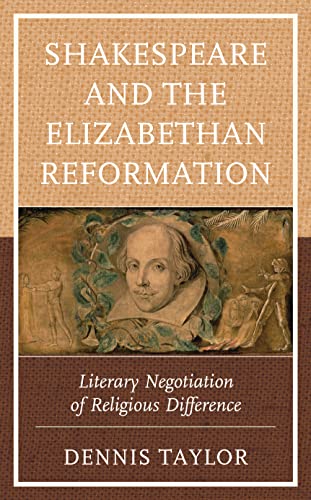Shakespeare’s Reformation

The Elizabethan Reformation was, paradoxically, a period of persecution, tolerance, and reconciliation between English Protestants and Catholics as they saw the coming impact of secularism. While “Protestantism negotiated the tension between Puritan impetus and Anglican characteristics,” “Catholicism negotiated its commitment to recusancy and accommodation.” Theatrical performances provided a venue to explore the societal implications of these conflicting Christian notions.
In Shakespeare and the Elizabethan Reformation, Dennis Taylor argues that Shakespeare is the ideal type of an artist utilizing stage performances and lyrical writing to wrestle with cultural changes. According to Taylor, by bringing Protestantism into negotiation with Catholicism, Shakespeare’s work produced a development of secularism. Thus, Shakespeare has ended up being a celebrated Christian dramatist with a secular allure.
Taylor opens his argument with the crux of Shakespeare’s tetralogy series–Henry VI. Henry represents the old Catholic England, which was washed away by the Reformation. Shakespeare was able to initiate conversations about the Reformation’s negative impact by comparing and contrasting England before and after Henry. After his martyrdom, Henry’s saintly characteristics and piety, appearing differently if one is a Lancastrian or Yorkist, unified English nationalists and Catholic devotees. Taylor writes, “Always in Shakespeare, assassination is more than the killing of a king but the destruction of a whole world order. Henry VI is to Shakespeare, as the ghost of King Hamlet is to Hamlet…the ghost of Catholicism past has become an increasingly uncanny phenomenon.” Shakespeare makes Henry’s murder increasingly holy because his character exemplifies the beginning of sacrilegious deaths in the Reformation. The assassination of Henry VI, at the outset of Shakespeare’s religious writing conquest, gives him the impetus to explain the Yorkists’ (Richard II) murderous motivation to kill an anointed king, who represents “piousness, goodness, and old Catholicism.”
Shakespeare’s move from historical plays to comedic ones relays criticism by highlighting papal error, mocking priests, and exposing an exorcism undergone by society during the Reformation. Taylor tells readers that Shakespeare’s remarks regarding the nomenclature of errors can be compared to Edmund Spenser’s Faerie Queene. Spenser’s presentation of Protestant and Catholic ideas helps readers understand the world around them from a holistic Christian perspective, and Shakespeare does the same by strategically incorporating into his plays issues about the Reformation many at the time did not want to overtly discuss. The Bard of Stratford-upon-Avon intended to bring error into the light by engaging with controversial conflicts; his works exposed papal error when the church refused to reveal the Reformation’s negative effects on society. Papal error primarily appears through dialogists such as “recusants and priests” in the comedies through the exercise of determining new trends in society and understanding them through theatrical performances. In Shakespeare, Taylor says, the interaction of black and white magic with Catholicism is heavily emphasized. For Henry and his family, naturalistic interpretations of the religious do not refute, but rather exist alongside, a natural reverence demonstrated by holy prayers and charitable duties of their order. A world of joyous metamorphosis keeps changing religion into the natural and back again. Both realities are in the plays. However, because the “demonic subject” of magic has not been dealt with until the Reformation, Shakespeare is charting a new course.
Black and white magic only one of the overarching subjects Shakespeare wanted to uncover, subjects including biblical changes to heterosexual marriage, humanism, love and adultery, rape, sex, gender, and idolatry. Catholicism is decorated with the importance of marital love, and Shakespeare knew his plays must call into question what love meant during a time when males played both female and male parts. This could potentially change sexual identity for the actors and the play’s seemingly straightforward message to the audience. For instance, in Twelfth Night, Shakespeare tackled gender by having male actors play Violet, a female who is disguised as a man. This crossing of genders could not be too suggestive, but it negotiated a need, sprung from the Reformation, to grapple with gender-related issues (a conversation which, as this shows, is far from modern).
Shakespeare’s career, depicted by Taylor, was his way of trying to analyze and articulate public issues during the Reformation. To Shakespeare, “his literary career was a war of solitude, rest, dreams, family, with death and murder being the only subjects left.” As Shakespeare’s career progressed, he used language of sophisticated proportions, which led to “occasional obscurity of people continuing to find depths of insight and beauty.” This sophisticated and obscure language has made Shakespeare’s pieces interactive by requiring the audience/readers do the interpretive work. This kind of interpretation is not just literary but also historical. As a result, those on the other side must “find themselves wrestling with the ghost of Hamlet (old Catholicism) and all that has happened since.” In this book, a key to unlocking Shakespeare’s works is understanding the battle between secularism, Protestantism, and Catholicism during the Reformation. Shakespeare’s ultimate intentions, Taylor concludes, were to help himself and others determine what secularism meant for a post-Reformation society.




